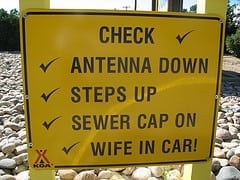 Reading Time: 5 minutes
Reading Time: 5 minutesAs you might recall, I started writing a series of search engine optimization tips. I started with search engine optimization tip number one, the title tag. Now, after 35 search engine optimization tips, I thought I would do a quick wrap-up of all of the SEO tips so you can reference what I’ve written about so far.
Contents
As I’ve said before, each one of these SEO tips should not take a long time to fix (or to check to see if you are following the search engine optimization best practices), and will be rather “short and sweet” and directly to the point. Take a look through the list and see if there’s anything that you might have missed.
Title Tag
Probably one of the most important search engine optimization ranking factor, the title tag must contain the keyword that you’re targeting on the web page where it appears. All web pages need a unique title tag.
Meta Description Tag
Always use a unique meta description tag on your web pages. Don’t use the same one, use one that is unique to the web page where it appears. Make sure it is custom-written for that web page. The meta description tag is often used in the search results, especially if they keyword someone searched for appears there.
Keywords on Your Web Page
Use the keywords on your web page in your copy. If your web page is about SEO, then mention SEO several times on your web page. Don’t just mention it once, mention it more than that. But don’t overdo it.
Meta Keywords Tag
If you use this meta tag on your web page, and you should, then make sure that the keywords you use in that meta tag are used on the web page where that meta tag appears.
Linking to your Home Page
Link to the real home page of your web site, this is http://www.yourdomainname.com/ and not http://www.yourdomainname.com/index.html. That’s pretty simple and make sense: I’m amazed at how many web sites do NOT do that.
Keywords in your URL
Name your web pages appropriately. If your web page is about search engine optimization, I would expect it to be called “search-engine-optimization.html” or something similar to that. I wouldn’t expect that web page to be named 12363.html.
Anchor Text of Internal Links
Pay attention to how you are linking to your other web pages on your web site internally. Describe each web page using the appropriate anchor text. The anchor text of the link should match the main keyword(s) in the title tag of the page you’re linking to.
Keywords in Alt Tags
Not only will this help your web site be more ADA compliant by helping blind people read your web site, you will help the search engines learn more about the images on your web pages.
Checking External Links
From time to time it’s important to take a look at who you are linking to. You might have a link on your web site that used to be pointing to a great resource: but it since might have gone away and some domainer bought the domain name and pointed it to a site where you don’t want to link. Check your outgoing links.
Linking Out to other Web Sites
Not only is it important to link to your own internal web pages, it’s important to be a good internet citizen and link out to other trusted web sites. I always try to link out to a trusted source like Wikipedia or another trusted source: directly to a resource on the topic you’re talking about. So, if your page is about search engine optimization, link out to the Wikipedia page about search engine optimization like I just did in this sentence.
Keywords in Heading Tags
Heading level tags like the H1, H2, and H3 tags are important to use on your web pages, and it’s important to put your keywords in your heading tags. Just don’t overdo it.
Text Surrounding Links
Carefully watch the text that surround the links on your site and the links to your web site. That text is imporant, as it can help the search engines figure out what your site is about and whether or not they will “count” your link or not. Read this tip to learn more.
Remove Unused Meta Tags
There are a lot of meta tags that you just do not need on your web site. I only really recommend that you have a meta description tag on your site and a few others. Remove the meta tags that are not necessary.
Fix Duplicate Content
Duplicate content can be a real big issue for some web sites. Google does not like lots of duplicate content. Every page on your web site should be unique.
Adding Content to your Web Site
Add content to your site on a regular basis. Don’t just have a static web site that sits there and doesn’t have new, fresh content.
Add a Breadcrumb Trail
Adding a breadcrumb trail on your site is not only a good idea to help your visitors see where they are. It is good for the search engines, and you may be able to include link text that will help rankings.
Review Links and Reputation
Review the links to your web site and what others are saying about you and your web site. You might miss a good linking opportunity if you don’t look at what others are saying.
Linking within Sentences
The search engines are looking for links that make sense, those links that are in the middle of a sentence. It’s better to have a link in a sentence rather than have a link buried in a footer or somewhere where someone won’t see it.
Move JavaScript to External File
Moving code off of your web page and into an external file can help with “code bloat” on your web pages. Focus on putting the content that matters on your web pages.
Whois on Domain Name
Check the whois listing on the domain names you own; if they’re not correct then make sure they are correct. Sometimes we overlook things like this.
Redirecting Traffic to Your Site
Pay attention to how your are redirecting traffic to your web site.
Link Building Using Coupons
Everyone nowadays is always looking for a deal. Why not issue a few coupons and let people know about those coupons; other websites will link to it.
Issue a Press Release
Consider issuing a press release and distributing it not only via press release distribution sites but send it directly to those who you think will be interested in it, including the reporters who have written about you in the past; and don’t forget the bloggers out there.
Links Across Multiple Domain Names
It is important to make sure that you don’t have a lot of links from the same domain name. I recommend trying to get one or two links from one domain name, and spreading out your links across multiple domain names. One link from one web site should be sufficient.
Use the Canonical Tag
If you have a website that is dynamic in nature, you might want to read up on the canonical tag and how it can possibly help you deal with issues like duplicate content on your website.
Check for 404 Errors
You could be missing out on traffic, visitors, and links to your website that you do not know about. View your 404 errors and see which URLs on your website you need to redirect.
So, there you have it, an overview/wrapup of all of my search engine optimization tips that I have added to the blog so far. Take a quick look and perhaps bookmark this post as a reference. I certainly have, as I refer back to it quite often when optimizing a web site. I am certainly not done with these tips, so as I add more in the future I will continue to update this web page with the tips. So, stay tuned…
At Vizion Interactive, we have the expertise, experience, and enthusiasm to get results and keep clients happy! Learn more about how our SEO Audits, Local Listing Management, Website Redesign Consulting, and B2B digital marketing services can increase sales and boost your ROI. But don’t just take our word for it, check out what our clients have to say, along with our case studies.




